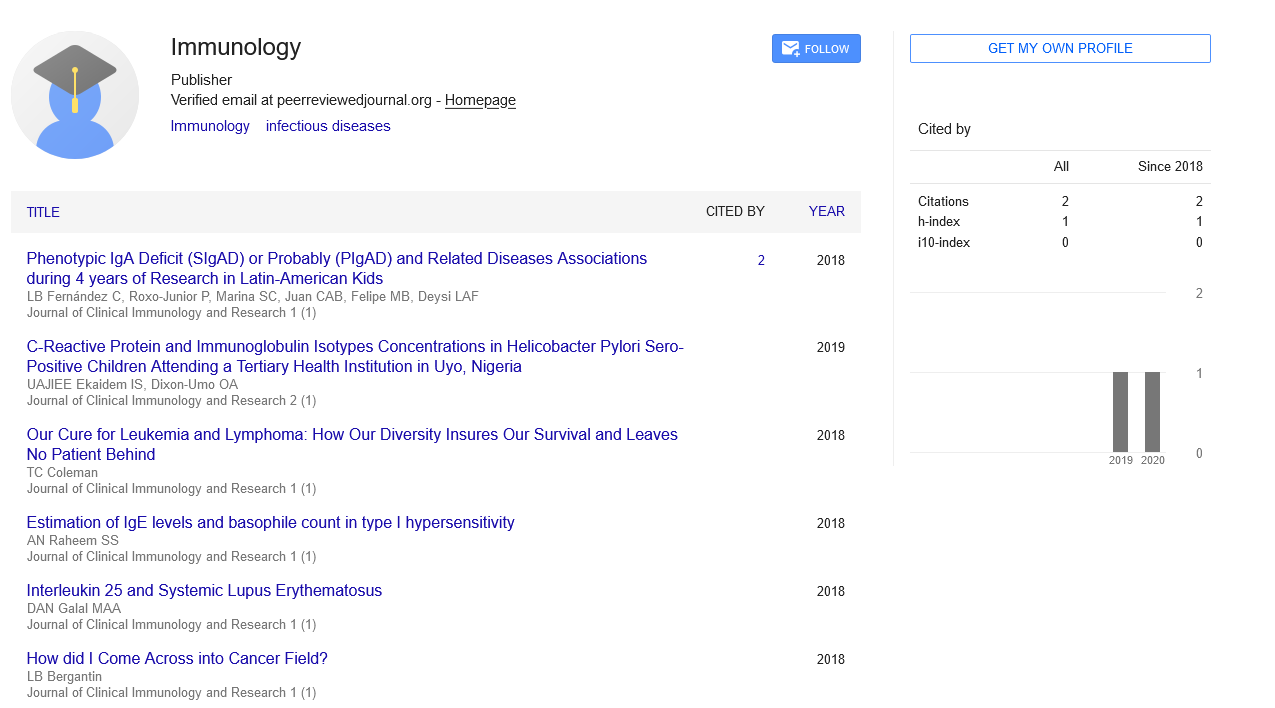Perspective, J Clin Immunol Res Vol: 8 Issue: 1
The Role of Innate Immunity in Infectious Diseases
Zeineb Cornec*
Department of Rhumatology, Brest University, Brest, France
*Corresponding Author: Zeineb Cornec
Department of Rhumatology, Brest University, Brest, France
E-mail:cornecz@gmail.com
Received date: 27 December, 2023, Manuscript No. JCIR-23-123659;
Editor assigned date: 29 December, 2023, PreQC No. JCIR-23-123659 (PQ);
Reviewed date: 12 January, 2024, QC No. JCIR-23-123659;
Revised date: 19 February, 2025, Manuscript No. JCIR-23-123659 (R);
Published date: 26 February, 2025, DOI: 10.4172/JCIR.1000092
Citation: Cornec Z (2025) The Role of Innate Immunity in Infectious Diseases. J Clin Immunol Res 8:1.
Abstract
Infectious diseases continue to pose a global threat to human health, necessitating a thorough understanding of the body's defense mechanisms. Innate immunity, the first line of defense against pathogens, plays a crucial role in the early recognition and elimination of invading microorganisms. This manuscript explores the intricate and dynamic role of innate immunity in infectious diseases, delving into the mechanisms of pathogen recognition, the activation of innate immune responses, and the crosstalk with adaptive immunity. By comprehensively reviewing the current literature and integrating recent advancements, this manuscript aims to provide a comprehensive overview of the pivotal role innate immunity plays in safeguarding the host against diverse infectious agents.
Keywords: Infectious; Pattern Recognition Receptors (PRRs); Toll-Like Receptors (TLRs); Nod-Like Receptors (NLRs)
Introduction
The introduction sets the stage by defining infectious diseases as a persistent global health challenge. It emphasizes the importance of understanding the early responses mounted by the immune system and introduces the concept of innate immunity as the initial line of defense. The section outlines the primary objectives of the manuscript, highlighting the need for an in-depth exploration of innate immune mechanisms in infectious diseases.
Description
Innate immune components and pathogen recognition
This section delves into the key components of innate immunity, including physical barriers, Pattern Recognition Receptors (PRRs), and soluble mediators. The manuscript elucidates how these components work synergistically to recognize a wide array of pathogens, including bacteria, viruses, fungi, and parasites. Special emphasis is placed on the diverse PRRs, such as Toll-Like Receptors (TLRs) and Nod-Like Receptors (NLRs), and their role in sensing Pathogen-Associated Molecular Patterns (PAMPs).
Activation of innate immune responses
The manuscript explores the mechanisms underlying the activation of innate immune responses upon pathogen recognition. It discusses the initiation of signaling cascades, the production of proinflammatory cytokines, and the recruitment of immune cells to the site of infection. The section also delves into the concept of inflammation as a doubleedged sword, highlighting its protective role in eliminating pathogens while emphasizing the potential for collateral tissue damage.
Crosstalk between innate and adaptive immunity
This section elucidates the dynamic interplay between innate and adaptive immunity, emphasizing how early innate responses shape subsequent adaptive immune reactions. The manuscript discusses antigen presentation, the activation of T and B cells, and the establishment of immunological memory. Examples of how innate immunity influences the direction and strength of adaptive immune responses are highlighted, showcasing the intricate coordination between these two arms of the immune system.
Innate immunity in specific infectious diseases
Drawing on specific examples, this section explores the role of innate immunity in different infectious diseases. Case studies, such as the innate immune response to viral infections like influenza or bacterial infections like tuberculosis, provide insights into the diversity of strategies employed by the immune system to combat specific pathogens. The manuscript also addresses how pathogens evade or manipulate innate immune responses for their survival and propagation.
Modulation of innate immunity for therapeutic interventions
The manuscript discusses therapeutic strategies that leverage our understanding of innate immunity. This section explores how the modulation of innate immune responses can be employed for the development of vaccines, immunomodulatory drugs, and targeted interventions against infectious diseases. Examples of successful therapeutic approaches and ongoing research in this domain are presented.
Challenges and future perspectives
The manuscript acknowledges challenges in the study of innate immunity, including the complexity of host-pathogen interactions and the need for a more nuanced understanding of tissue-specific responses. Future perspectives include the integration of systems biology approaches, advances in immunomodulatory therapies, and the potential for precision medicine in tailoring interventions based on individual immune profiles.
Conclusion
In conclusion, this manuscript provides a comprehensive overview of the pivotal role of innate immunity in infectious diseases. By unraveling the mechanisms of pathogen recognition, early immune responses, and the dynamic crosstalk with adaptive immunity, we gain valuable insights into the complex interplay that determines the outcome of infections. A deeper understanding of innate immunity not only enhances our knowledge of host defense mechanisms but also holds promise for the development of innovative therapeutic strategies against infectious diseases.
 Spanish
Spanish  Chinese
Chinese  Russian
Russian  German
German  French
French  Japanese
Japanese  Portuguese
Portuguese  Hindi
Hindi 